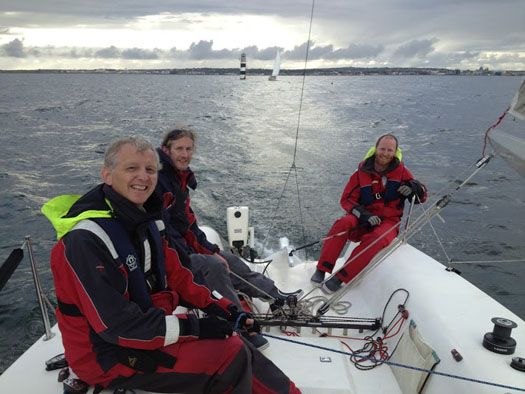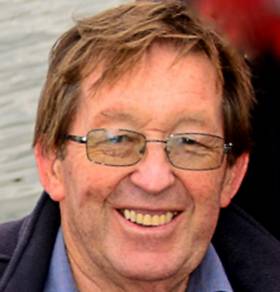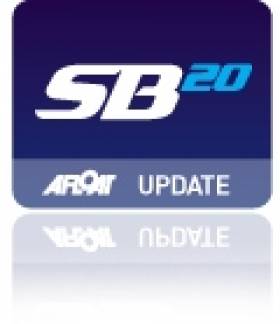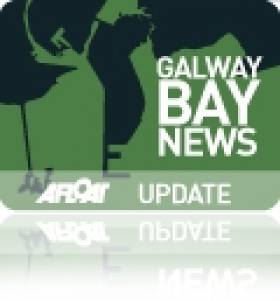Displaying items by tag: GBSC
Naval Service Officer Returns to Galway Bay Sailing Club Where He First Learned His Skills
A Naval Service officer has paid tribute to the efforts of instructors at Galway Bay Sailing Club (GBSC) who rescued a man off Rinville pier last month.
Lieut Jason Croke from Clarenbridge, Co Galway also spoke to young sailors about pursuing a career in the Naval Service during a visit to GBSC.
Croke, a diver who also works in Naval Service operations, learned to sail at GBSC and qualified as an instructor there.
During his visit to Rinville, he extolled the training which the clubs provide, and the value of the skillsets passed on to young sailors.
He was asked many questions during the 40-minute discussion, and outlined options and career opportunities to the older members of the group of about 30 sailors.
Croke met Callie Ní Fhlannchaidha, senior instructor at GBSC, and 15-year old powerboat driver Cormac Conneely who were involved in pulling a man from a vehicle that shot off Rinville pier near Oranmore on the afternoon of July 3rd last.
 Robert Donnelly and juniors after a sail at Galway Bay Sailing Club meet Lieut Jason Croke
Robert Donnelly and juniors after a sail at Galway Bay Sailing Club meet Lieut Jason Croke
The pair had been instructing local sea scouts on the water and had been bringing two groups of the scouts ashore when the incident occurred.
With the assistance of a local Galway hooker sailor Sean Furey, who was on the water in a currach, Ní Fhlannchaidha and Conneely towed the car ashore.
Fellow instructors onshore, including Tom Ryan, Ben Schumaker, Ella Lyons, Veronica O’Dowd and Mattie Kennedy, assisted in the rescue effort.
 Instructor Olivia Croke watches on as Instructor Isabella Irwin presents a GBSC burgee to Lieutenant Jason Croke on his visit to the club where he learned to sail.
Instructor Olivia Croke watches on as Instructor Isabella Irwin presents a GBSC burgee to Lieutenant Jason Croke on his visit to the club where he learned to sail.
Conneely expressed his interest in joining the Naval Service on leaving school - and to volunteer for the RNLI Galway lifeboat crew when he is old enough.
On foot of this, an invitation was issued to Lieut Croke by GBSC founder member Pierce Purcell.
Purcell paid tribute to the Naval Service officer for his visit, which he said was inspiring for young members.
GBSC celebrated its 50th-anniversary last year and runs sail training courses for children from six years old up to junior cadet level.
The club’s Optimist and 420 class juniors are particularly successful, according to rear commodore Pat Irwin.
GBSC Lamb's Week 2021
GBSC hosts Lambs Week from August 19th to 25th when some 50 boats will take part in the five-day regatta. It includes a number of races for four classes from Ros-a-Mhíl, with a day’s race around the Aran islands and from there to Roundstone in Connemara.
The Lamb’s Week schedule is:
- Thu 19 Aug, Galway to Ros a'Mhíl
- Fri 20 Aug, Ros a'Mhíl to Cil Rónáin
- Sat 21 Aug, 'Round Aran
- Sun 22 Aug, Cil Rónáin to Cloch na Rón
- Mon 23 Aug, Cloch na Rón to Ros a'Mhíl/Galway
Afloat's WM Nixon Will Tell Galway Sailors That Irish Were First To Leave Gaff Rig
Afloat.ie’s W M “Winkie” Nixon will be talking the talk at Galway Bay Sailing Club’s mid-week gathering at 8pm on Wednesday, February 1st in the re-vamped clubhouse at Rinville in Oranmore, and all are welcome.
The hospitable GBSC clubhouse is at the heart of one of the main sailing centres on a coastline as much renowned for its association with gaff-rigged traditional craft as it is for being the base for some of Ireland’s most modern offshore racers. But in a wide-ranging profusely-illustrated talk, one of the points Nixon will be making is that it was leading Irish amateur sailors who were in the forefront of the changeover from gaff to Bermudan rig.
Drawing on his extensive experience of sailing both abroad and in Ireland (which he has cruised or raced round more times than he can remember), as a sailing journalist and historian Nixon has discerned significant sailing trends which first emerged in Ireland, but became obscured by major national historical events.
However, he promises that the main theme of his talk – “When Gaffers Weren’t Old” – is the sheer pleasure and fascination of sailing. Admission is free and open to all, but a seaboot at the door will be there to receive €5 from anyone who feels like contributing to the Lifeboats.
Strangford Trio Win SB20 Westerns at Galway Bay Sailing Club
#sb20 – Northern Ireland's Darren Martin, Roger Pannel and Simon Murray were popular winners of the SB20 Western Championships in Galway at the weekend. Results available to download below.
The 'Wild West' obliged with most races in more than 14 knots–18 knots on Galway Bay. Although number were down (13 boats) due to sailors of the SB20 class competing elsewhere at the weekend there was still plenty of post race festivities at McSwiggins Yacht Club on Galway docks. Of the four SB20 regattas so far this year, it is the first time teams that have been on the podium twice, an indication of a good spread of winners over the season's events.
Martin's Strangford Lough crew won on count back from Graeme Grant, Ronan Downing and Breffini. Third was Dave Taylor with Marty O'Leary, Lisa Neary and Rachael Mc Williams. Dave Barry won the silver fleet and took a few notable gold fleet scalps in the process.
SB20 president Justin Burke concluded that 'Galway Bay was a fantastic place to race with Galway Bay Sailing Club offering superb organisation'. Burke maintains more classes should consider Galway with the 'wind and waves and McSwiggins YC supporting the social side!'
Galway Bay Club Hosts Disabled Sailing Championships
#gbsc – Galway Bay Sailing Club, for the first time in it's history, is very proudly hosting an "All Ireland" sailing event for sailors with a disability writes Lorraine Scully This national event will bring together the largest collection of disabled sailors ever assembled in Galway for a great weekend of competitive sailing. GBSC have 17 boats entered from Cork, Dublin, Belfast and Galway with 19 competitors.
The All Ireland HANSA 303 Nationals is in it's third year. 2014 in Galway will be the first time in Irish Sailing history that both juniors and adults with a disability will compete in various races over Saturday and Sunday 19th and 20th July.
Dave Vinnel, GBSC commodore, is very excited to bring these Nationals to Galway – while the club has experience of running many national sailing events this is the first time we will do so for disabled sailors. With the help of our very generous sponsors and a strong band of volunteers we are all really looking forward to welcoming sailors from all over Ireland, North and South.
Due to its stability the Hansa 303 is ideal for disabled sailors. Sailing is one of the very few activities for people with a disability that achieves parity with able bodied peers on the water. The thrill, excitement and freedom experienced by all sailors becomes universal.
For the past number of years GBSC has had growing participation from junior sailors with a disability working closely with Galway Speeders the Galway based multi-sport club for children with a physical disability whose aim is to promote sport for young people with a physical disability. GBSC now has 7 boats for use by sailors with disability and demand still out strips supply!
Just this week wheelchair users will also find the GBSC boat yard more accessible thanks to very generous sponsorship from Cold Chon Ltd who tarred a large section of the dingy park making it more accessible and wheelchair friendly.
Racing will take place from 1-4pm on Saturday and 11.30-2:30 on Sunday and all are welcome to come and visit.
Registration from 9.30 Saturday 19th for competitors
Club house open to all visitors all weekend
For more information phone Bridgette Brew 086 335 9962.
#gbsc – The final race of the GlenncahillCars.com April Series concluded last Wednesday with the final race a 'non-discard' to ensure it would all be up for grabs on the night. Eight boats were on the water to contest this first series of the year in a combined class at the Galway club and the weather delivered perfect racing conditions over five Wednesday evenings.
Liam Burke's Corby 25 'Tribal' came to the last race with a 2 point advantage over Glenn Cahill's 'Joie de Vie' but the J109 crew were clearly up for the challenge. They started well mid-line but an early cross with Martin Breen's Reflex 38 'Lynx', who returned on port from the obstruction of the South shore, leading to a strong verbal exchange. But the protest flags remained folded. This was Lynx's first evening race and her young crew performed admirably.
'Tribal' were caught in dirty air from 'Ibaraki', the GK34 formerly known as 'Joggernaut' with John Collins on the helm, forcing them to tack away as Rob Allen's Corby 25 'Smile' crossed ahead.
Approaching Cockle rock, a slight left shift favoured the leaders on that side and they hoisted to extend the lead on the run down to Oranmore mark.Barry Heskin's Dubois 32 'Now What' opted for the gybe set with Jim Grealish calling tactics. On the beat to Mutton Island the wind gusted to 18 kts and, as positions became established, boats focused on speed as it would all come down to corrected time.
Joie de Vie sailed nigh on the perfect race but ultimately it wasn't enough as Tribal took second place, enough to secure the series.
Racing continues at GBSC with the Western Surveyor Summer Series with a split in the classes as more boats come on the water. The White Sail Fleet also have their first outing.



































































